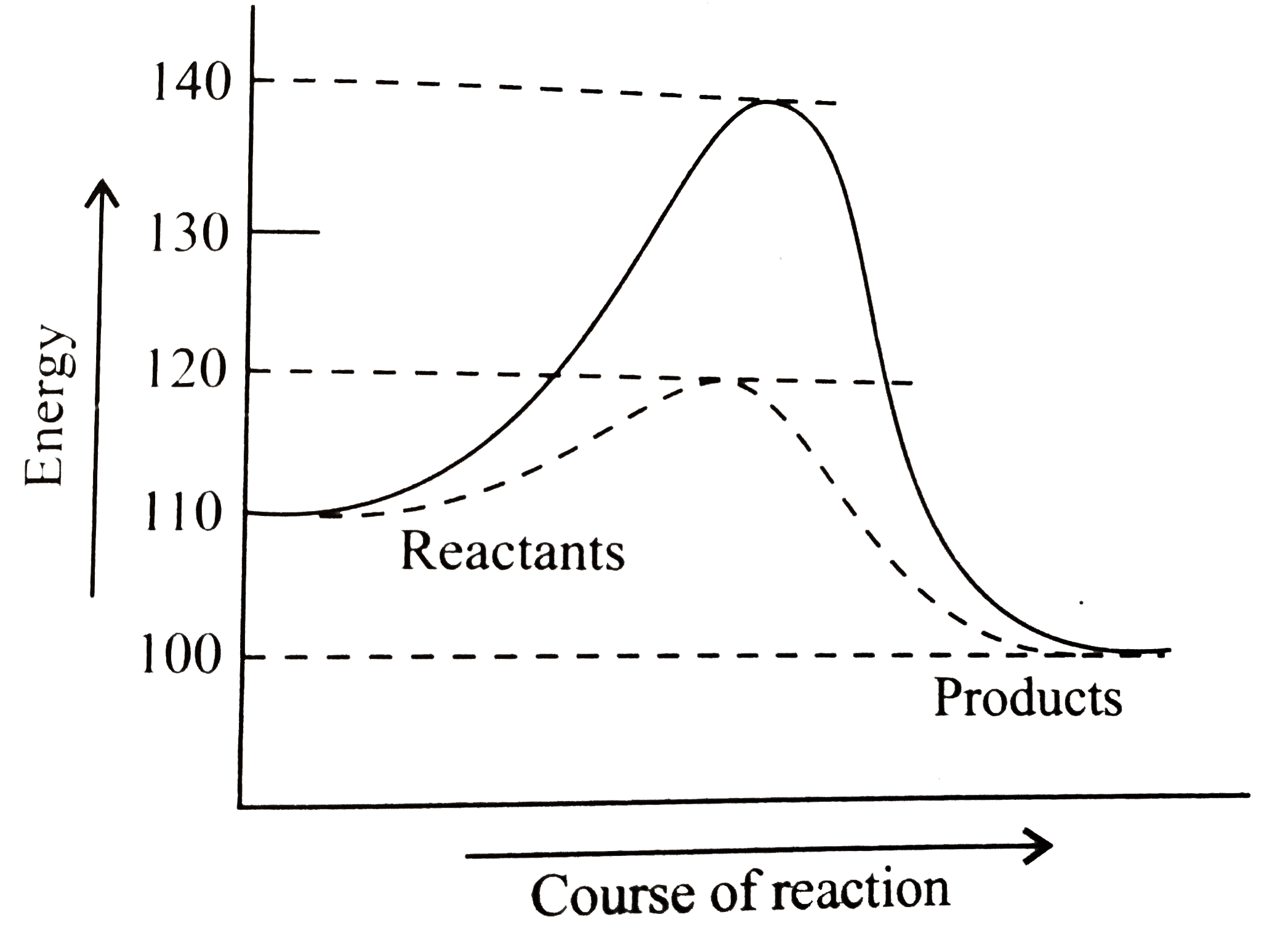Given : A⇔B+C,ΔH=−10 kcals, the energy of activation of backward reaction is 15 kcal mol−1. If the energy of activation of forward reaction in the presence of a catalyst is 3 kcal mol−1 the catalyst will increase the rate of reaction at 300 K by the number of times equal to
e3.33
e4.21
e−2.7
e2.303
The correct Answer is:A
To solve the problem step by step, we will follow these calculations:
Step 1: Understand the Given Information
We are given:
- Reaction: A → B + C
- ΔH = -10 kcal (indicating an exothermic reaction)
- Activation energy of the backward reaction (EAB) = 15 kcal/mol
- Activation energy of the forward reaction in the presence of a catalyst (EAF') = 3 kcal/mol
Step 2: Calculate the Activation Energy of the Forward Reaction (EAF)
Using the relationship between the activation energies and the enthalpy change (ΔH):
EAF−EAB=ΔH
Substituting the known values:
EAF−15 kcal/mol=−10 kcal/mol
Now, solve for EAF:
EAF=−10+15
EAF=5 kcal/mol
Step 3: Use the Arrhenius Equation to Find the Increase in Rate
The formula that relates the rate constants with and without the catalyst is:
KCK=eEA−EA′RT
Where:
- KC = rate constant with catalyst
- K = rate constant without catalyst
- EA = activation energy without catalyst (EAF = 5 kcal/mol)
- EA′ = activation energy with catalyst (EAF' = 3 kcal/mol)
- R = gas constant = 1.987 cal/(mol·K) = 0.001987 kcal/(mol·K)
- T = temperature = 300 K
Step 4: Substitute Values into the Equation
Now we substitute the values into the equation:
KCK=e5 kcal/mol−3 kcal/mol(0.001987 kcal/(mol⋅K))(300 K)
Calculating the exponent:
KCK=e2 kcal/mol0.5961 kcal/mol
KCK=e3.354
Step 5: Calculate the Final Value
Now we can calculate e3.354:
Using a calculator or mathematical software:
e3.354≈28.7
Conclusion
The catalyst will increase the rate of reaction at 300 K by approximately 28.7 times.
---
We are given:
- Reaction: A → B + C
- ΔH = -10 kcal (indicating an exothermic reaction)
- Activation energy of the backward reaction (EAB) = 15 kcal/mol
- Activation energy of the forward reaction in the presence of a catalyst (EAF') = 3 kcal/mol
Using the relationship between the activation energies and the enthalpy change (ΔH):
EAF−EAB=ΔH
EAF−15 kcal/mol=−10 kcal/mol
EAF=−10+15
EAF=5 kcal/mol
The formula that relates the rate constants with and without the catalyst is:
KCK=eEA−EA′RT
- KC = rate constant with catalyst
- K = rate constant without catalyst
- EA = activation energy without catalyst (EAF = 5 kcal/mol)
- EA′ = activation energy with catalyst (EAF' = 3 kcal/mol)
- R = gas constant = 1.987 cal/(mol·K) = 0.001987 kcal/(mol·K)
- T = temperature = 300 K
Now we substitute the values into the equation:
KCK=e5 kcal/mol−3 kcal/mol(0.001987 kcal/(mol⋅K))(300 K)
KCK=e2 kcal/mol0.5961 kcal/mol
KCK=e3.354
Now we can calculate e3.354:
Using a calculator or mathematical software:
e3.354≈28.7
The catalyst will increase the rate of reaction at 300 K by approximately 28.7 times.
Topper's Solved these Questions
- CHEMICAL EQUILIBRIUMBook:VMC MODULES ENGLISHChapter:CHEMICAL EQUILIBRIUMExercise:IMPECCABLE
Explore 50 Videos
- CHEMICAL EQUILIBRIUMBook:VMC MODULES ENGLISHChapter:CHEMICAL EQUILIBRIUMExercise:Illustration
Explore 24 Videos
- CHEMICAL EQUILIBRIUMBook:VMC MODULES ENGLISHChapter:CHEMICAL EQUILIBRIUMExercise:ENABLE
Explore 49 Videos
- CHEMICAL BONDING-I & IIBook:VMC MODULES ENGLISHChapter:CHEMICAL BONDING-I & IIExercise:JEE Advanced (Archive)
Explore 98 Videos
- CHEMICAL KINETICS Book:VMC MODULES ENGLISHChapter:CHEMICAL KINETICS Exercise:JEE Advanced (Archive)
Explore 52 Videos
Similar Questions
The major product of the following reaction is:

View Solutionin a reversible reaction the energy of activation of the forward reaction is 50 kcal .
the energy of activation for the reverse reaction will be
View SolutionHow is activation energy of a reaction affected?
by using a catalyst
View SolutionHow is activation energy of a reaction affected?
by using a catalyst
View SolutionHow is activation energy of a reaction affected?
by using a catalyst
View SolutionA poistive catalyst increases the activation energy of the reaction.
View SolutionThe energy of activation for a reaction is 100KJmol−1. The peresence of a catalyst lowers the energy of activation by 75%. What will be the effect on the rate of reaction at 20∘C, other things being equal?
View SolutionEnergy of activation of forward and backward reaction are equal in case (numerical calues) where
View SolutionRefer picture given below.
(a) Calculate ΔH for the reaction and the energy of activation for the forward reaction as well as backward reaction.
(b) The dotted curve is in the presence of a catalyst. What is the energy of activation for the two reactions in the presence of catalyst?
( c) Will the catalyst change the extent of reaction?

View SolutionThe activation energy for a first order reaction is 60 kJ mol−1 in the absence of a catalyst and 50 kJ mol−1 in the presence of a catalyst. How many times will the rate of reaction grow in the presence of the catalyst if the reaction proceeds at 27∘C ?
View Solution
